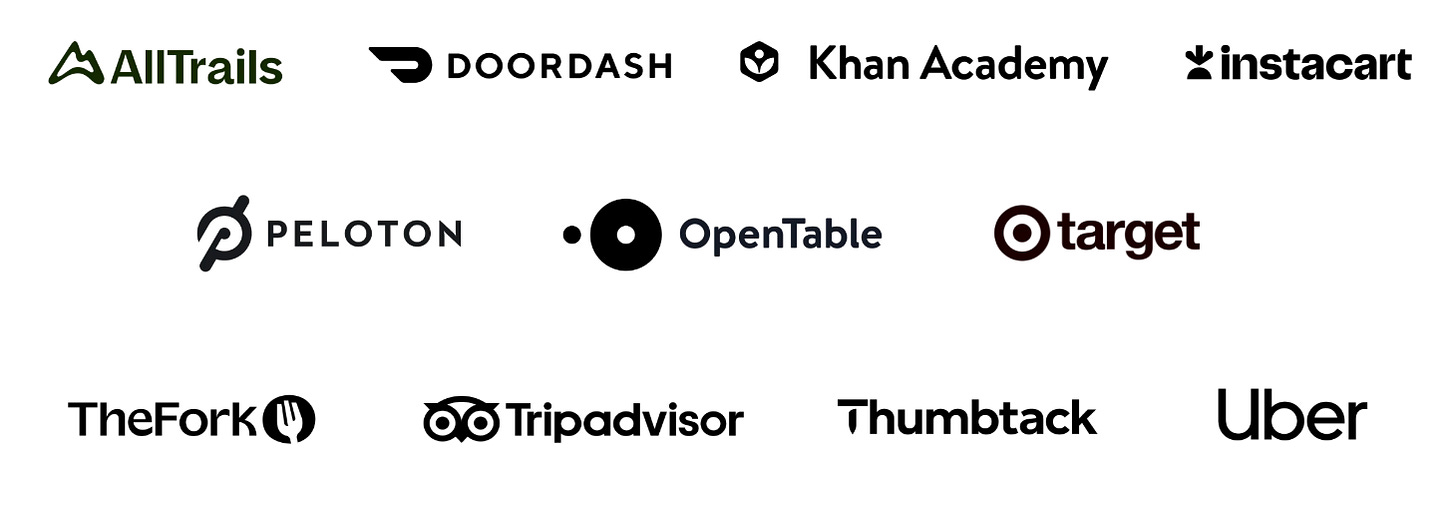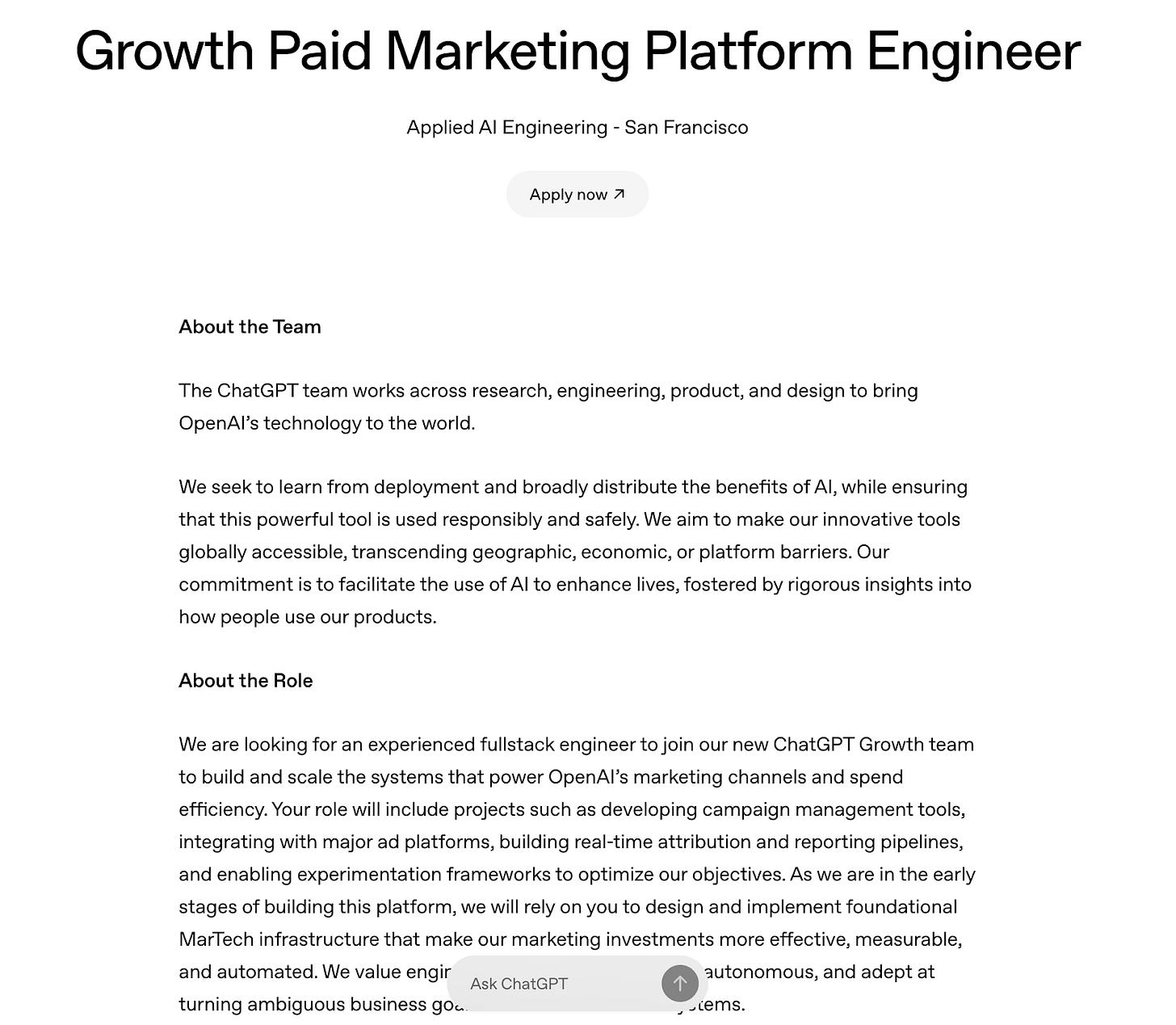Where is OpenAI heading?
DevDay just turned ChatGPT into a platform, not just a product
👋 Hey, I’m George Chasiotis. Welcome to GrowthWaves, your weekly dose of B2B growth insights—featuring powerful case studies, emerging trends, and unconventional strategies you won’t find anywhere else.
This note is brought to you by Restartt.
How do you know your company isn’t losing customers to a competitor CEO who’s active on LinkedIn?
Very often, that’s the real cost of your CEO having no voice on the platform.
That’s true for most B2B companies. Yes, even those in ‘boring industries.’
At my new LinkedIn Growth Agency, Restartt, we interview your CEO, ask the right questions, and turn their voice into content that drives business outcomes.
And, we’re so confident in our service that we offer the first month free, with no commitments.
The only catch: we work with just one company per month.
Apply here to see if you qualify
On October 6, 2025 (that’s yesterday, if you’re reading this close to publishing), OpenAI held its annual DevDay event in San Francisco.
You know how these events go, but for context, here are some headlines you might have already seen on your LinkedIn feed…
“OpenAI just killed…”
“Did OpenAI just destroy…”
“What OpenAI announced changes everything…”
We’ve all seen those headlines.
I usually let the dust settle before weighing in.
In other words, trendspotting isn’t really my style.
But even if I don’t want to make a big deal of what they announced…
Some of the things they announced really are a big deal.
The announcements
Not all announcements are relevant to marketers.
This was a DevDay event after all.
Let’s double-click on the ones that were.
1. Apps in ChatGPT + Apps SDK
Here’s what OpenAI announced:
OpenAI launched an SDK that lets developers build apps inside ChatGPT.
Users can interact with integrated apps (e.g., Spotify, Canva, Zillow) without leaving the chat.
Why does it matter?
Your brand, tools you’ve created, or tools you’ve partnered with can live inside ChatGPT and be searchable.
Even though Google search increasingly served applications (e.g., flights, calculators) as part of the results, this takes things to a whole new level.
Your content is no longer the only ‘searchable’ asset in ChatGPT’s results.
Some of the apps/partners OpenAI plans to integrate into its search results later this year include:

Of course, not all prompts/questions have a job-to-be-done search intent.
Many of them have informational search intent, which could be covered by content alone.
However, even if something begins with a prompt asking for information on a given topic, it can easily evolve into a prompt asking for a specific task (related to that topic) to be completed.
For example, think of the following prompt sequence:
What is trail cycling?
What equipment do I need for trail cycling?
Is there an easy cycling trail near Bryce, Utah?
Enter: AllTrails (the partner from the screenshot above)
A few things are still unclear.
What we can say with some confidence is that this has the potential to disrupt (the already disrupted) search landscape even further.
It presents an opportunity, but also a challenge for marketers and brands alike.
2. AgentKit
Here’s what OpenAI announced:
A toolkit to build production-grade agents (e.g., autonomous workflows) using OpenAI models.
Why does it matter?
For marketing, agents could automate complex, multi-step user journeys.
For example, a “social media agent” that drafts, optimizes, and schedules a campaign, or a “customer success agent” that handles multi-turn conversational flows.
It lowers the barrier to deploying smart, automated experiences.
It also makes many SaaS companies—or, at least certain of their features—irrelevant.
The reason why this is important for marketers is that the expectation of ‘efficiency’ will now be even more prevalent.
Simply put, marketers will have to deal with the question:
“You have a playground for agents right into ChatGPT, why can’t you help us automate things and save money?”
There will be a push for efficiency, and at the same time, productivity gains will be achieved.
I don’t know yet whether the agents users build will be searchable through a marketplace (similar to the one for GPTs), but it is possible.
As I mentioned earlier, there were additional announcements, but not all of them are directly related to marketers, even though they can indirectly impact their work.
Let’s add a couple more things into the mix.
Add these three elements to the mix
A few days before DevDay, OpenAI released its next-generation video and audio generation model, Sora 2.
I’m not going to go into the details of Sora 2 and why it’s better than Sora 1.
Element #1: Sora as a standalone social app
Alongside launching Sora 2, OpenAI also introduced a new iOS app named Sora (initially invite-only, available in the U.S. & Canada) that functions like a vertical short video/social feed.
The app is designed more like TikTok / Instagram Reels / “For You”-style feed, but with a twist:
All content is AI-generated (via Sora 2) rather than user-recorded video.
The feed supports liking, commenting, and remixing other users’ generated videos.
This means that OpenAI is expanding its product strategy to social media. (Keep that for later.)
Element #2: Free user monetization
OpenAI is hiring for a Growth Paid Marketing Platform Engineer.

It may sound random, but OpenAI’s goal to monetize free users is clear.
Is this a sign that ads are coming to ChatGPT?
The answer is yes.
It’s not clear how soon we’ll see that, but it’s coming.
It’s the next logical step.
Because think about it:
Google has dominated the search category for over 20 years and created a cash-generating machine like no other.
And where did the bulk of the revenue come from?
Well, no need to guess because we all know it came from ads.
Element #3: Instant checkout
OpenAI also introduced Instant Checkout—its new in-chat shopping feature that turns it from a discovery tool into a transactional destination.
When a user asks for product suggestions (e.g., “running shoes under $100” or “gifts for a book lover”), ChatGPT surfaces relevant product options from across merchants.
If a product supports Instant Checkout, the user can tap “Buy,” confirm shipping and payment details, and complete the purchase entirely within the chat interface (e.g., without leaving ChatGPT).
The merchant remains responsible for the order—processing payment, fulfillment, returns, and customer support—using their existing backend systems. ChatGPT essentially acts as a secure intermediary, passing data between the user and the merchant.
The announcement happened a few days before the DevDay, on September 29, 2025.
Which brings us here.
Where things are heading
I don’t have a crystal ball, and I generally steer away from predictions.
But, I think it’s pretty evident that the direction we’re heading is one where:
OpenAI launches a social media app. If you’re OpenAI and have 800 weekly ChatGPT users, you want to make sure these users spend more time on the platform and have the ability to interact with other users. This way, the product becomes more sticky, and the user forms an emotional connection with it that goes beyond prompts and chatbot-like interaction.
OpenAI launches an ads platform and starts serving ads on its search results. This is an excellent opportunity for monetization and expanding its revenue streams beyond paid subscriptions or businesses paying for access to its APIs.
ChatGPT becomes the place to do everything—search for movies, book tickets, play music, and more. The ultimate goal: build a super-app (similar to the one Elon Musk wants to build with X) that keeps you there because, let’s be honest, you don’t have anywhere else to go.
The thing is, we can’t say with certainty that they’ll achieve all of these things.
I mean, I’d expect them to have some misses, too.
However, if they achieve at least two out of three, then ChatGPT and OpenAI’s ecosystem of apps (I’m not sure what the right term here is) will become one of the most important channels for online marketing.
Will they succeed?
Only time will tell.
Final thoughts
I’d like to tell you not to worry about all these changes and to focus on the basics instead.
The basics still work, and likely will for the foreseeable future.
The problem here lies in the word ‘foreseeable’ because no one can really predict what the future will look like.
And I’m not talking about five to ten years down the line—I’m talking about six months from now.
Online fear mongers aside, you see that a single event can create a tsunami of changes for the whole tech ecosystem.
The best we can do is monitor, stay clear-headed, and keep investing in what works.
Thank you for reading today’s note, and see you again next week.



